In pursuit of wherries and like the photographer Peter Henry Emerson before her, Melissa Mouchemore crosses the River Yare.
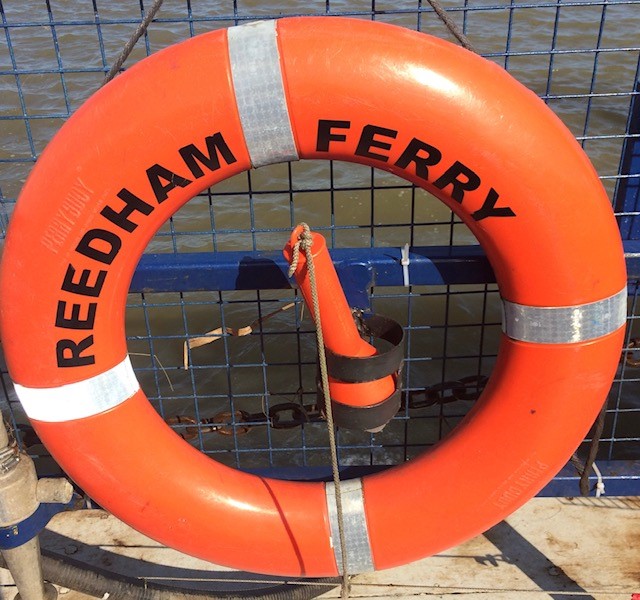
The Norfolk Broads – seven rivers, 125 miles of navigable waterways. There must be a ferry.
On the River Yare for instance, looping its way to the east coast and dividing the Broads, North from South. No road bridges connect the two sides on the 20 odd miles between Norwich and Great Yarmouth; you have to drive into the edgelands of either and join the hurtle of the A-roads, a flash of a river sign the only clue to what runs beneath. It would make sense to have some ferries in between.
And at several points on the map, ferry roads and lanes do indeed rise up and drift over lonely marshes, over the endless Etch A Sketched gridlines of mill leats and dykes, only to evaporate at abandoned staithes. Ferry ghosts. Until finally, on the southernmost bend of the Yare, right away from any conurbation, a more substantial Ferry Road heads southwards to the riverbank at Reedham; the one surviving ferry on the river.
The Yare is sun-filled but restless at the equinox as I watch the ferry’s manoeuvres from the bank; the chains urgent like a teleprinter hammering out football results, bilges spluttering, ramps raised in surrender. This is the ‘new’ ferry, new in 1983 that is, steel framed, oak planked and ‘slotted built’ so the river flows under and through. Which is what is happening now as the spring tide charges inwards. I see a gull sail past on an island of reeds at quite an alarming clip. As a foot passenger I board when the ferryman tells me once he has finished marshalling the vehicles, two at a time.
I am hoping to spot a Norfolk wherry, once the cargo carriers of the Broads network, many built right here by Halls of Reedham. Timber, coal, sugar beet, scrap metal, ice and tar; it was all moved along by the wiry wherrymen first sailing, then by diesel. There are only a handful left, raised from the mud by enthusiasts, the clinker-built hulls restored, the overlapping oak planks replaced at considerable cost and effort. I look out now for a distinctive rust-red sail. Well, any sail would be nice — but the rivercraft today are all of the fibreglass, floating conservatory kind.

In the 1880s and 90s Peter Henry Emerson, acquaintance of Whistler, distant cousin of Ralph Waldo, explored the Broads extensively, sometimes sailing by wherry. The new railway links brought him from London to photograph birds. But instead he must have become enraptured by the people and the place, embarking on an immense photography project – 8 books, the first entitled Life and Landscape on the Norfolk Broads. A breathtakingly beautiful depiction of a hardly believable world: an eel-catcher and his home like a floating shepherd’s hut, a marsh woman in her straw hat and apron, bearing the reed harvest on some kind of stretcher, a marshman perched on top of a hay rick piled on a punt, ‘quanting’ the boat with a pole through the drainage channels. All Emerson’s photographs were carefully composed with poses held for the exposure time his large camera needed. How did he persuade his subjects to ‘freeze’? He must have been determined, possibly obsessed, lugging his cumbersome equipment across the marshes, along river walls and over ‘liggers’ — the planks of wood carried by the marsh people so they could cross the drains too wide to jump. What did they think of this incomer?
Perhaps they were becoming more used to such visitors. One of Emerson’s photographs hints at this. Like all his work it’s in soft charcoals, pewter and marble greys. In the background, beyond brimming marshes, a cottage settled on the curve of the river. Wood smoke horizontal, the suggestion of a windmill. And in the foreground the distinctive unfurled single sail of a wherry. It is entitled ‘The Old Order and the New’. But what is new here? Looking closer below the sail, three figures are seated in the hull without the usual Wherry ‘cuddy’ or cabin, two with the oars out, the other steering. Here are three men in a boat. The new order — leisure boaters.
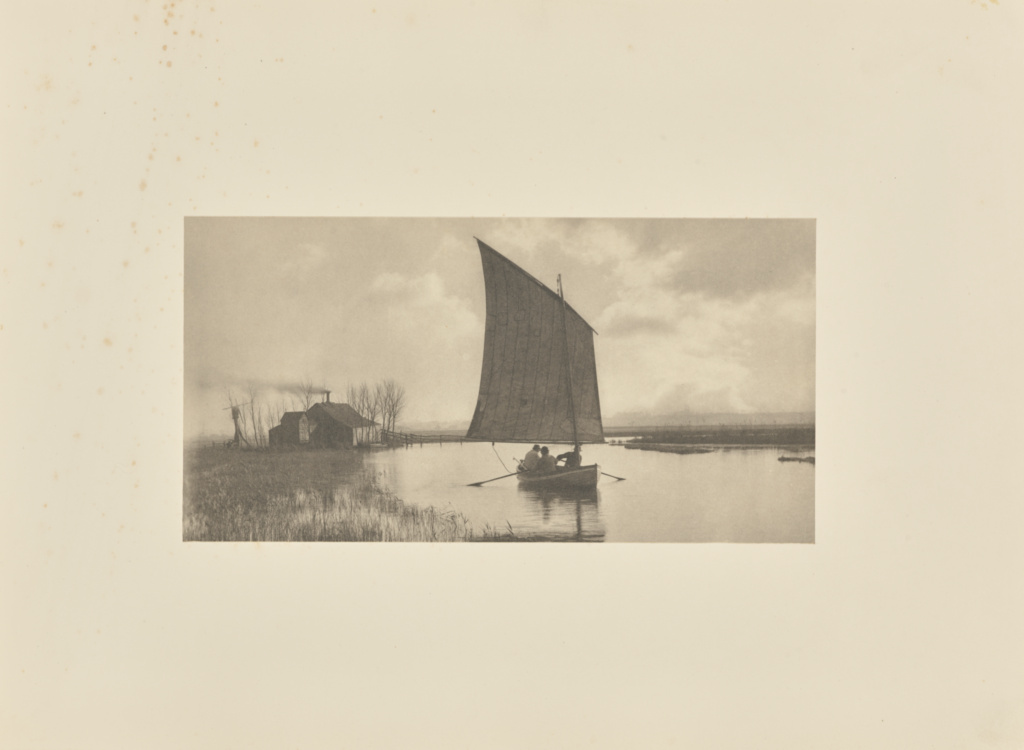
Mid-channel the ferry abruptly slows and I look round to catch a marine motorhome swerving past, no heed being paid to the river signs warning of ferry chains. A tanned woman in satin top and jaunty captain’s hat sits aloft at the wheel, her friends lounging on cream padded seats, toasting with prosecco, all sporting pink wings.
The ferryman appears unfazed, unsurprised.
It was a leisure boater arriving by steam train from London who became the custodian of the Ferry Inn and its boat in 1949. Norman Archer saw it was all up for sale while on holiday and on the spot, made an offer, moved his family out of London, and subsequent generations still run the whole operation. Probably enraptured like Emerson.
The ramp gently lowers, revealing the other half of Ferry Road, which on this side runs south-west all the way to Nogdam End. Enclosed by the riverbank on one side, expanses of flat farmland on the other, it is filled with a queue of vehicles. I sidle up the grass verge, realizing this is no place for a pedestrian.
‘Excuse me Sir!..Sir!’
What’s this?
‘Sir, you have rolled back into my car!’
A woman has sprung out of her Land Rover Discovery and, after trying to engage with the offender in the car in front, is now shrugging in exasperation at the Damp Control van behind. The damp men don’t want to be drawn in. It is unlikely they can even see beyond the Discovery’s height and girth. But I can see the culprit’s boot lightly resting against the raised bumper. A Robin Reliant getting its breath back. The old boy inside is also taking a moment, trying to work out what just happened. But the woman will not leave him be — Sir! So he finally heaves himself out and unwisely starts rubbing the Discovery’s shiny plastic with the sleeve of his cardigan as the woman folds her arms.
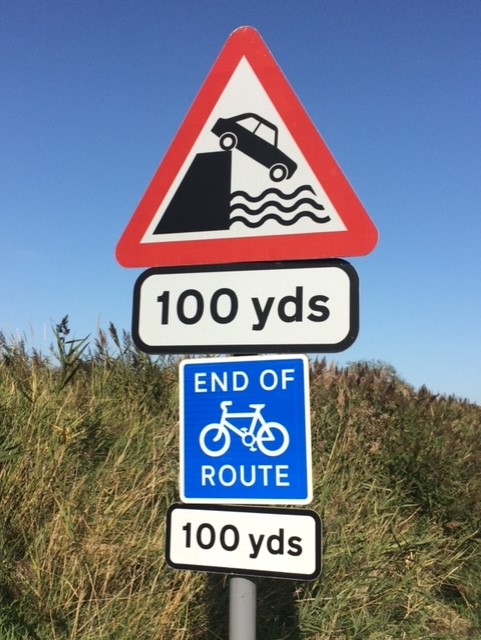
I count the vehicles in the queue 2 by 2. Oh no — they are going to be on the ferry together. But just as their turn comes the former ducks into the layby used by elderly ferry-picnickers whilst the latter zips into pole position. Followed by the damp men. The old boy watches the ramp raise. Closure and clear water.
I realise that, other than the layby, there isn’t much for a foot passenger on this side — no wonder the ferryman let me over for free — any walking, the pub and village are all on the Reedham side.
I sheepishly re-board on the next crossing. A vast motorhome takes up more than one space so I can walk around and look out both sides. The ‘old’ timber-framed ferry could take 2 1960s cars, maybe 3 Robin Reliants. The ‘new’ ferry can squeeze in 2 Land Rover Discoverys but that’s the limit; it can’t be bigger or the tide will catch it. So as vehicles have grown it’s the queues that get longer. I would not have bothered the ferrymen in the days before hydraulics when they had to physically winch across, in spring tides pulling the ferry in with a block and tackle. They had their work cut out particularly on ‘sale’ days with farmers, livestock and horses pulling laden carts. But out here mid-river I am grateful for my free ride, the Yare splintering with mirrorball light, fringed with flouncing reed-beds. It is easy to see why Norman Archer made his snap decision.
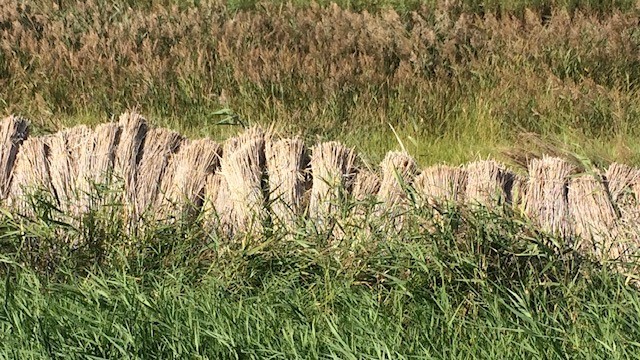
I head up along the recently named Wherryman’s Way on the Ferry Inn side to get closer to the reeds; the common reed, prized by thatchers for its straight, hollow stems and durability on roofs. Reedham means ‘homestead by the reeds’ and I am surrounded by them now — 3-metre-high ranks of jointed eau de nil canes, topped with shawl tassel seed plumes, the colour of pot pourri. They shush, tut and rattle at me.
There are still reed-cutters about, I warn, they’ll get you with the mower. And this is the surprising thing — for although Emerson knew in the 1880s that he was capturing disappearing trades and ways of life, a few men and women are newly learning this physically demanding trade. The reed-beds with their rich eco-system need regular cutting to survive or willow scrub invades, turning the area into less diverse swampy ‘carr’. Emerson would not recognize the ride-on ‘lawn mower’ cutters but he would still see the occasional hook, scythe and rake. He would still be able to follow the reed-cutters over dykes, crossing channels on remaining liggers, some still lying where they were last dropped, and see some evidence of the reeds being knocked into bundles or ‘schoofs’, a dutch word he would have learned from the marsh people. I walk past a collection now, drying out on the edge of a drained saltmarsh pasture, a much rarer sight as floodwaters rise; although the reed-beds are now known to have flood protecting properties they alone cannot hold back the tide. It must be nearly tide turn now; the river was spilling up to the flinted wall of the pub when I walked off the ferry.
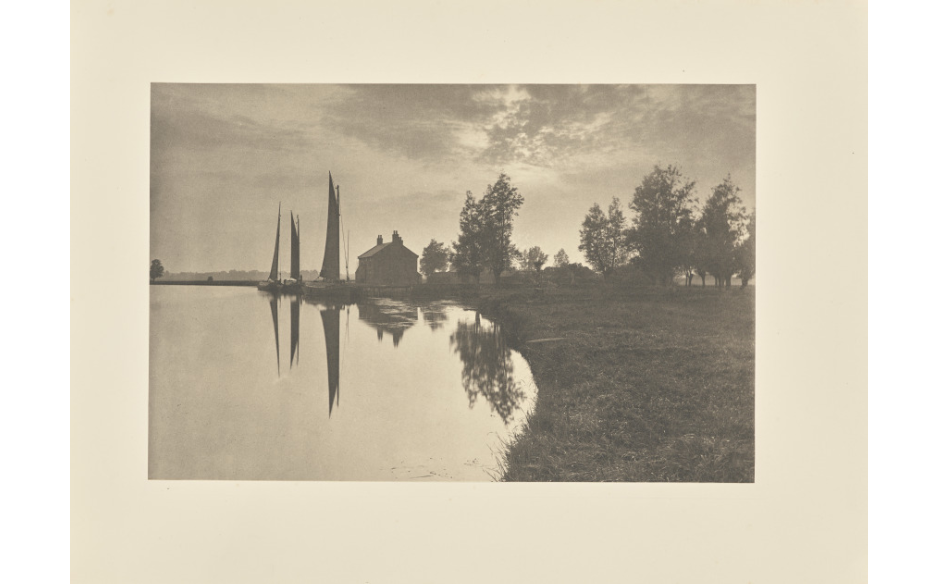
One of my favourite Emerson photographs depicts high tide just up the river wall from here — ‘Cantley: Wherries Waiting for the Turn of the Tide’. All wherrymen had to be expert tide-watchers, knowing that if they got it wrong they would be ‘quanting’ their cargo all the way to Yarmouth. Somehow Emerson captures the hush, the pause, the still point of tide turn through the dark sails mirrored in a mill pond Yare.
Incoming, out-going. The old order and the new. Whatever next.
But here at least is the ferry, placed just where the marsh people would expect it; a moving, oak-planked ligger bridging the gap.